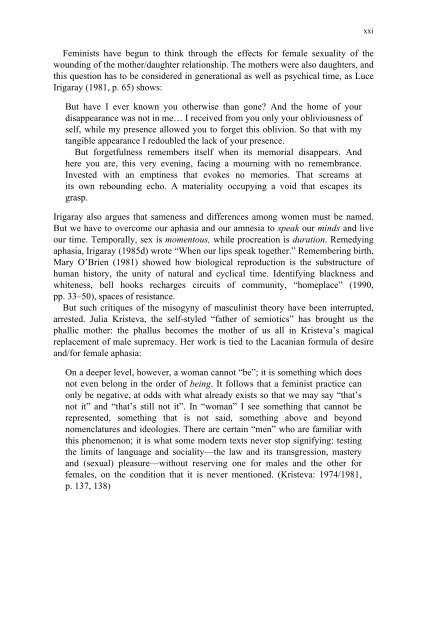Nothing Mat(t)ers: A Feminist Critique of Postmodernism
Nothing Mat(t)ers: A Feminist Critique of Postmodernism
Nothing Mat(t)ers: A Feminist Critique of Postmodernism
Create successful ePaper yourself
Turn your PDF publications into a flip-book with our unique Google optimized e-Paper software.
<strong>Feminist</strong>s have begun to think through the effects for female sexuality <strong>of</strong> the<br />
wounding <strong>of</strong> the mother/daughter relationship. The moth<strong>ers</strong> were also daught<strong>ers</strong>, and<br />
this question has to be considered in generational as well as psychical time, as Luce<br />
Irigaray (1981, p. 65) shows:<br />
But have I ever known you otherwise than gone And the home <strong>of</strong> your<br />
disappearance was not in me… I received from you only your obliviousness <strong>of</strong><br />
self, while my presence allowed you to forget this oblivion. So that with my<br />
tangible appearance I redoubled the lack <strong>of</strong> your presence.<br />
But forgetfulness rememb<strong>ers</strong> itself when its memorial disappears. And<br />
here you are, this very evening, facing a mourning with no remembrance.<br />
Invested with an emptiness that evokes no memories. That screams at<br />
its own rebounding echo. A materiality occupying a void that escapes its<br />
grasp.<br />
Irigaray also argues that sameness and differences among women must be named.<br />
But we have to overcome our aphasia and our amnesia to speak our minds and live<br />
our time. Temporally, sex is momentous, while procreation is duration. Remedying<br />
aphasia, Irigaray (1985d) wrote “When our lips speak together.” Remembering birth,<br />
Mary O’Brien (1981) showed how biological reproduction is the substructure <strong>of</strong><br />
human history, the unity <strong>of</strong> natural and cyclical time. Identifying blackness and<br />
whiteness, bell hooks recharges circuits <strong>of</strong> community, “homeplace” (1990,<br />
pp. 33–50), spaces <strong>of</strong> resistance.<br />
But such critiques <strong>of</strong> the misogyny <strong>of</strong> masculinist theory have been interrupted,<br />
arrested. Julia Kristeva, the self-styled “father <strong>of</strong> semiotics” has brought us the<br />
phallic mother: the phallus becomes the mother <strong>of</strong> us all in Kristeva’s magical<br />
replacement <strong>of</strong> male supremacy. Her work is tied to the Lacanian formula <strong>of</strong> desire<br />
and/for female aphasia:<br />
On a deeper level, however, a woman cannot “be”; it is something which does<br />
not even belong in the order <strong>of</strong> being. It follows that a feminist practice can<br />
only be negative, at odds with what already exists so that we may say “that’s<br />
not it” and “that’s still not it”. In “woman” I see something that cannot be<br />
represented, something that is not said, something above and beyond<br />
nomenclatures and ideologies. There are certain “men” who are familiar with<br />
this phenomenon; it is what some modern texts never stop signifying: testing<br />
the limits <strong>of</strong> language and sociality—the law and its transgression, mastery<br />
and (sexual) pleasure—without reserving one for males and the other for<br />
females, on the condition that it is never mentioned. (Kristeva: 1974/1981,<br />
p. 137, 138)<br />
xxi

















